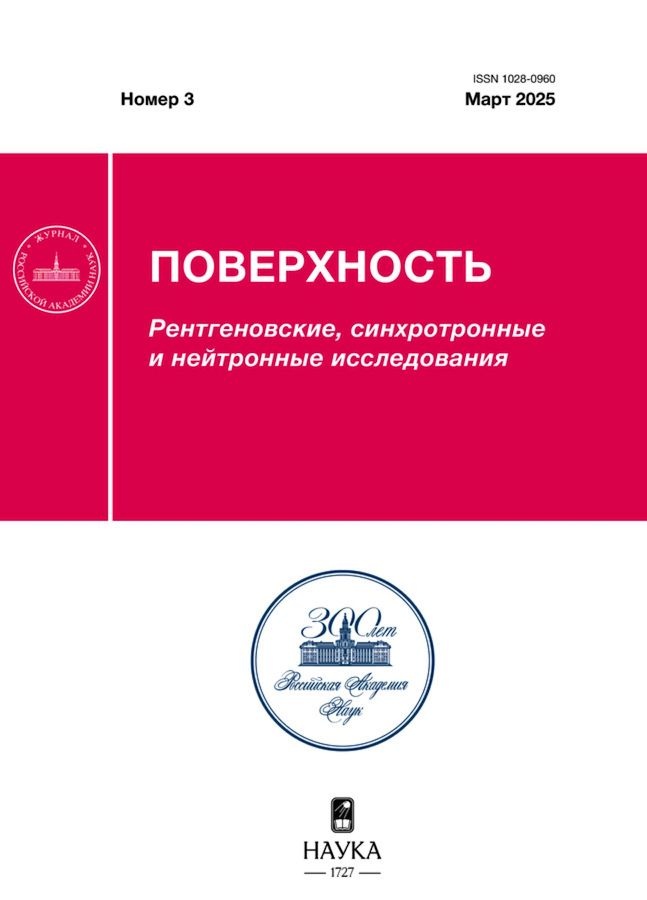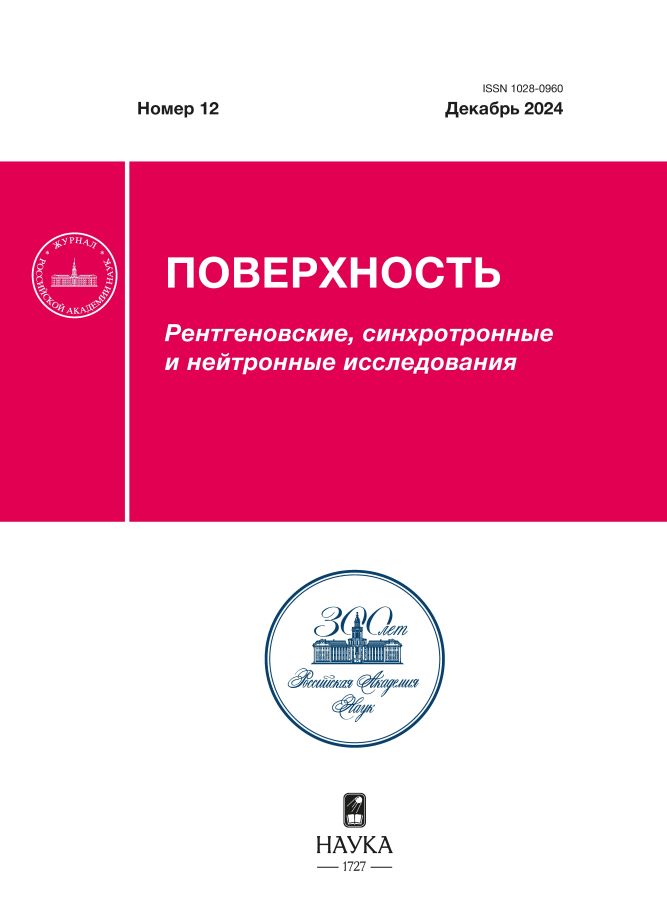Исследование пленки нитрида кремния, в которую имплантированы ионы цинка
- Авторы: Привезенцев В.В.1, Фирсов А.А.1, Куликаускас В.С.2, Киселев Д.А.3, Сенатулин Б.Р.3
-
Учреждения:
- Научно-исследовательский институт системных исследований Российской академии наук
- Московский государственный университет им. М.В. Ломоносова
- Национальный исследовательский технологический университет “МИСИС”
- Выпуск: № 12 (2024)
- Страницы: 38-45
- Раздел: Статьи
- URL: https://transsyst.ru/1028-0960/article/view/685353
- DOI: https://doi.org/10.31857/S1028096024120049
- EDN: https://elibrary.ru/QXGGUU
- ID: 685353
Цитировать
Полный текст
Аннотация
Приведены результаты исследования нанокластеров в пленке Si3N4 на подложке из Si, в которую имплантированы ионы 64Zn+ с энергией 40 кэВ при дозе 5×1016/cм2. Пленку Si3N4 наносили на кремниевую подложку газофазным методом. Затем образцы после имплантации отжигали на воздухе в диапазоне температур 400–700°С с шагом 100°С в течение 1ч на каждом шаге. Морфология поверхности образцов была исследована с помощью сканирующей зондовой микроскопии. Профили имплантированной примеси и элементов пленки, а также химическое состояние иона Zn исследовали с помощью рентгеновской фотоэлектронной и оже-электронной спектроскопии. Методом сканирующей зондовой микроскопии обнаружено, что после имплантации вблизи поверхности пленки Si3N4 зафиксированы отдельные кластеры металлического цинка размером порядка 100 нм и менее. В процессе отжига происходит их рост с одновременным превращением в фазу ZnSiN2 и, возможно, в фазы оксида и силицида цинка вблизи поверхности. После отжига при температуре 700°С в пленке Si3N4 образуются Zn-содержащие кластеры размером около 100 нм.
Ключевые слова
Полный текст
Об авторах
В. В. Привезенцев
Научно-исследовательский институт системных исследований Российской академии наук
Автор, ответственный за переписку.
Email: v.privezentsev@mail.ru
Россия, Москва
А. А. Фирсов
Научно-исследовательский институт системных исследований Российской академии наук
Email: v.privezentsev@mail.ru
Россия, Москва
В. С. Куликаускас
Московский государственный университет им. М.В. Ломоносова
Email: v.privezentsev@mail.ru
Научно-исследовательский институт ядерной физики
Россия, МоскваД. А. Киселев
Национальный исследовательский технологический университет “МИСИС”
Email: v.privezentsev@mail.ru
Россия, Москва
Б. Р. Сенатулин
Национальный исследовательский технологический университет “МИСИС”
Email: v.privezentsev@mail.ru
Россия, Москва
Список литературы
- Litton C.W., Collins T.C., Reynolds D.S. Zinc Oxide Materials for Electronic and Optoelectronic Device Application, Wiley, Chichester, 2011.
- Zain J.H., Ramkumar J., Sankaran C., Tyagi A.K. // Separation Science Technology. 2019. V. 55. Iss. 11. P. 1. https://www.doi.org/10.1080/01496395.2019.1617746
- Straumal B.B., Mazilkin A.A., Protasova S.G., Myatiev A.A., Straumal P.B., Schütz G., van Aken P.A., Goering E., Baretzky B. // Phys. Rev. B. 2009. V. 79. P. 205206. https://www.doi.org/10.1103/PhysRevB.79.205206
- Liu Y.X., Liu Y.C., Shen D.Z., Zhong G.Z., Fan X.W., Kong X.G., Mu R., Henderson D.O. // J. Cryst. Growth. 2002. V. 240. P. 152.
- Urfa Y., Çorumlu V., Altındal A. // Mater. Chem. Phys. 2021. V. 264. P. 124473. https://doi.org/10.1016/j.matchemphys.2021.124473
- Sirelkhatim A., Mahmud S., Seeni A., Kaus N.H.M., Ann L.C., Bakhori S.K.M., Habsah H., Dasmawati M. // Nano-Micro Lett. 2015. V. 7. P. 219. https://www.doi.org/10.1007/s40820-015-0040-x
- Inbasekaran S., Senthil R., Ramamurthy G., Sastry T.P. // Intern. J. Innov. Res. Sci. Engineer. Technol. 2014. V. 3. Iss. 1. P. 8601.
- Smestad G.P, Gratzel M. // J. Chem. Educ. 1998. V. 75. P. 752.
- Amekura H., Takeda Y., Kishimoto N. // Nucl. Instrum. Methods Phys. Res. B. 2004. V. 222. P. 96. https://doi.org/10.1016/j.nimb.2004.01.003
- Yang J., Liu X., Yang L., Wang Y., Zhang Y., Lang J., Gao M., Wei M. // J. Alloys Compd. 2009. V. 485. P. 743. https://doi.org/10.1016/j.jallcom.2009.06.070
- Shen Y., Li Z., Zhang X., Zhang D., He W., Xue Y., Gao Y., Zhang X., Wang Z., Liu C.L. // Optical. Mater. 2010. V. 32. Iss. 9. P. 961. https://www.doi.org/10.1016/j.optmat.2010.01.033
- Zatsepin D., Zatsepni A., Boukhvalov D.W., Kurmaev E.Z., Pchelkina Z.V., Gavrilov N.V. // J. Non-Cryst. Solids. B. 2016. V. 432. P. 183. https://www.doi.org/10.1016/j.jnoncrysol.2015.10.002
- Tereshchenko A.N., Privezentsev V.V., Firsov A.A., Kulikauskas V.S., Zatekin V.V., Voronova M.I. // J. Surf. Investig.: X-ray, Synchr. Neutr. Tech. 2023. V. 17. P. 1232. https://www.doi.org/10.1134/S1027451023060198
- Gwyddion Programm. (2021) Czech Metrology Institute. http://gwyddion.net
- National Institute of Standards and Technology. (2000) Gaithersburg, USA. https://www.nist.gov
- Moulder J.F. Handbook of X-ray photoelectron spectroscopy. Physical Electronics, 1995. 230 p.
- Монахова Ю.Б., Муштакова С.П. // Журнал аналит. химии. 2012. Т. 67. № 12. С. 1044.
- Пирс К., Адамс А., Кац Л., Цай Дж., Сейдел Т., Макгиллис Д. Технология СБИС, в 2-х книгах. / Ред. Зи С.М. Пер. с англ. М.: Мир, 1986.
- Futsuhara M., Yoshioka K., Takai O. // Thin Solid Films. 1998. V. 322. P. 274.
- Coelho-Jún H., Silva B.G., Labre C., Loreto R.P., Sommer R.L. // Sci. Rep. 2021. V. 11. P. 3248.
- Анализ поверхности методами Оже- и рентгеновской фотоэлектронной спектроскопии/ / Ред. Бриггс Д., Сих М.П. Пер. с англ. М.: Мир, 1987. 181. с.
- MultiPak software. https://multipak.software.com
- Thermo Fisher Scientific. (2024) Thermo Fisher Scientific Inc., USA. https://www.thermofisher.com/
- Barr T.L., Seal S. // J. Vacuum Sci. Technol. A. 1995. V. 13. Iss. 3. P. 1239. https://doi.org/10.1116/1.579868
Дополнительные файлы



















